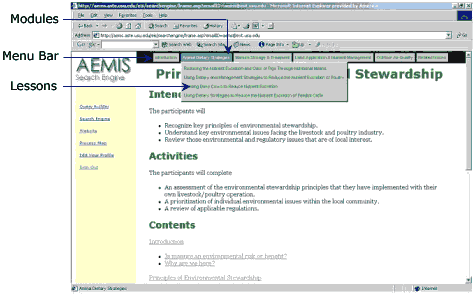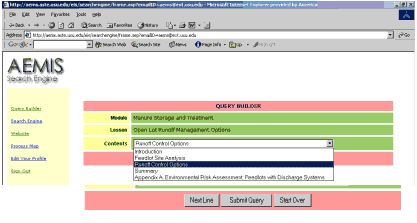February 2004 // Volume 42 // Number 1 // Tools of the Trade // 1TOT4
Agriculture Environmental Management Information System: An Online Decision Support Tool
Abstract
This article describes an enterprise information system, The Agriculture
Environmental Management and Information System (AEMIS), which provides
efficient and accurate access to the latest information about manure
management theories, methods, and tools for the livestock and poultry
industry.
Introduction
Many states are becoming attractive locations for the intensive production of livestock and poultry. More stringent county, state, and federal environmental regulations are forcing all industries to become better stewards of natural resources. It is likely that the focus on agriculture by consumers, environmentalists, and regulators will increase. This will create opportunities to improve agricultural systems, water quality, and manure and environmental management practices.
Agriculturists across the nation are constantly confronted with the real and perceived problems associated with the production of food and fiber in an environmentally sustainable way. Most of the time, the solutions to these problems may not be realized until the producers approach professional service providers such as an Extension specialist and agent, private consulting firms, and other state and federal field personnel.
For these service providers, the answers may not be readily available. They often refer to special bodies of knowledge in order to seek the solution. Traditionally and typically, this "body of knowledge" can be books or any other similar documentation. Thus, it is easy to imagine sifting through many documents to find a solution.
Cooperative Extension, as a professional service provider, is faced with increasing economic and environmental pressure from competition, government, and rapidly changing technology. These constraints have resulted in Extension asking fewer employees, often with fewer resources, to accomplish more. These pressures are not going to disappear. Providing good service is no longer "good enough."
Extension professionals must adapt a quality paradigm, one consistent with improvement of everything and everyone in the system. By embracing the quality approach to our services, Extension will begin moving toward being a world-class service provider. As part of this transformation, Extension professionals must appreciate that world-class service providers have world-class processes. A tool for process improvement within Extension is an enterprise information system.
System Overview
The Agriculture Environmental Management and Information System (AEMIS) at Utah State University is similar to the work done by the Idaho State Department of Water Resources. AEMIS is an enterprise information system that provides efficient and accurate access to the latest information about manure management theories, methods, and tools for the livestock and poultry industry.
The core of AEMIS is the valuable objective information addressing the issues of manure management and environmentally sensitive methods of on-site reduction, reuse, and recycling. The information has been developed, peer reviewed, and pilot tested by agricultural experts across the nation. It is highly beneficial to agriculturists in that it efficiently addresses real problems associated with the production of food and fiber, and can help the producers develop environmentally sustainable production systems.
The information was migrated into the tables after being parsed. The information is stored on a Web server in a Relational Database format, allowing for easy retrieval. The retrieval of the material is through Web-based technologies that include a Navigation System, a Query Builder, and a Keyword Search Engine.
The Navigation System (Figure 1) allows the user to browse through the information that is available by using pull-down menus and then clicking on the appropriate links for pertinent topics. This presents the user with an option of having a broad look at the contents in the information, as opposed to the other options that can allow the user to narrowly hunt down the information needed. As Figure 1 shows, the user is able to see all the root modules of the information on the top menu bar, which shows the lessons under that particular module.
Figure 1.
Navigation System

With the Query Builder, a user can build a step-by-step query by narrowing down to a particular subtopic under the topic. The user can build a question, the response to which will be generated from the database. While building a query, the user can traverse through all the levels of the information.
Figure 2.
Query Builder

Figure 2 shows when a user has traversed to the contents level of the query builder. The items seen in the drop-down list are only under the lesson Open Lot Runoff Management Options, which was selected as one of the many items under the module Manure Storage and Treatment. On submitting the query, information under that topic along with links to any subtopics are presented.
A third part of the system is the Search Engine, which takes the user to a more specific search tool. It allows the user to search the entire database by specifying the search keyword(s). Figure 3 shows the system after scanning the entire database and displays all the titles of the topics that contain the keyword(s). The titles are sorted according to the relevance of the keyword in the text. By clicking the link, the entire topic text will be displayed with the keywords highlighted. Thus, the user is presented with all the available information on the topic within the database.
Figure 3.
Search Engine

An option of doing an Advanced Search is given to the users through the Advanced Search link seen in Figure 3. This allows the user to refine his or her search, which, by default, is done by looking for at least one of the many words typed by the user in the data base. The Advanced Search gives the user two other options--search for the exact phrase and search for all the words.
Summary
The system will help producers and their advisors facilitate planning, controlling, monitoring, steps to corrective action, auditing, and review activities to ensure both that the environmental policy is complied with and that the agriculture environment management system remains appropriate. With its vast amount of information, this product can successfully provide access to sound, science-based information that is the key to implementing good environmental stewardship principles among producers, advisors, and policymakers.
To access AEMIS, go to the Utah Agriculture Environmental Management System Web site <http://aems.aste.usu.edu> and sign up as a cooperator. Log in, and access information will then be provided.
